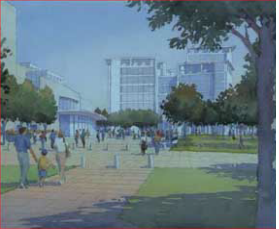
Palo Alto is considering easing a four-decade ban on buildings more than 50 feet tall to allow for construction of a building complex that would soar up to triple that height between downtown Palo Alto and Stanford University.
Prominent Silicon Valley philanthropist John Arrillaga has proposed plans for a theater, a revamped transit center and four office towers at 27 University Ave. The plans prompted the city to discuss modifying the height limit ordinance.
Residents and city planning commissioners have been wary of increasing the height limit in the past, fearing it would increase traffic and cast undesirable shadows in downtown Palo Alto.
City officials discussed the consequences of a height-limit change at an Oct. 10 Planning and Transportation Commission meeting. While no decisions were made, and there appeared to be no appetite to lift the ban completely, commissioners weighed increasing the height limit in certain areas, perhaps near the city’s major transit centers.
The commission raised many concerns, however, and asked the Architectural Review Board, a body that reviews all new construction requests, to provide more research on how a modification of the height limit would impact the community.
“If you evaluate potential impact, demographic shifts, schools, infrastructure, jobs, city budget and tax base, I don’t think this is in any way a simple proposition,” Planning Commission Vice-Chair Mark Michael said. “This can be an extremely complex discussion.”
The Arrillaga plan proposed last month includes four new office towers with heights greater than 100 feet, the tallest being 161-feet. It also includes a new theater, a public plaza, and significant improvements to the surrounding roads, according to details provided by the Palo Alto’s city website.
Currently, the historic MacArthur Park restaurant is located at 27 University Ave. Steve Emslie, the Palo Alto deputy city manager, said if the Council approves Arrillaga’s plans, MacArthur Park will relocate.
Commissioners agreed the topic of changing the building height limit should be considered separately from Arrillaga’s proposal. Emslie said the City Council has until Dec. 8 to decide whether to put the project before Palo Alto voters in March.

Palo Alto has rarely made exceptions to the height rule in the past, though there are several buildings that exceed 50-feet as a result of extensive negotiations. These exceptions include the 8-story Casa Olga building at 180 Hamilton Ave., the 11-story Channing House at 850 Webster St., and a 15-story office building at 525 University Ave.
Commissioner Samir Tuma questioned whether the 50-foot rule was outdated. The limit was originally designed in the 1970s to control growth in a town that residents didn’t want to feel too urban.
“What the situation was in 1974 is certainly different from what the situation is today” Michael said. “Reviewing the policy may be a very healthy discussion.”
Some commissioners said increasing the building height could help attract business.
“We need to keep innovative companies in the city,” Commissioner Greg Tanaka said. He explained that Bay Area tech giants Google and Facebook both got started in Palo Alto but then were forced to move out because of space constraints. Now, Google is in Mountain View, and Facebook is headquartered in Menlo Park. Tanaka expressed concern at how an influx of business could lead to an increase of residents and put pressure on Palo Alto’s highly rated schools.
Bob Moss, a Palo Alto resident for over 40 years, protested the potential height increase. At the Oct. 10 meeting, he called the prospect of towers along El Camino in Palo Alto, “ghastly’’ and said he wanted to “keep Palo Alto low-scale.”
“The more tall office buildings, the more jobs, and the more pressure for housing,” Moss told the commissioners, “The city should be designed for the people who live here, not outside developers.”
At the end of the October meeting, Commissioner Michael Alcheck explained what originally attracted him to Palo Alto.
“It shined overwhelmingly compared to all the other options on this peninsula,” he said. “The notion of radical change… I don’t fear it, but I tread cautiously. We must consider how we can create a community that will continue to have the vitality that attracted me to it.”
The Architectural Review Board will hold a public comment session on this issue at 8:30 a.m. Thursday. The session will take place in the Council Chambers at City Hall, 250 Hamilton Ave.
